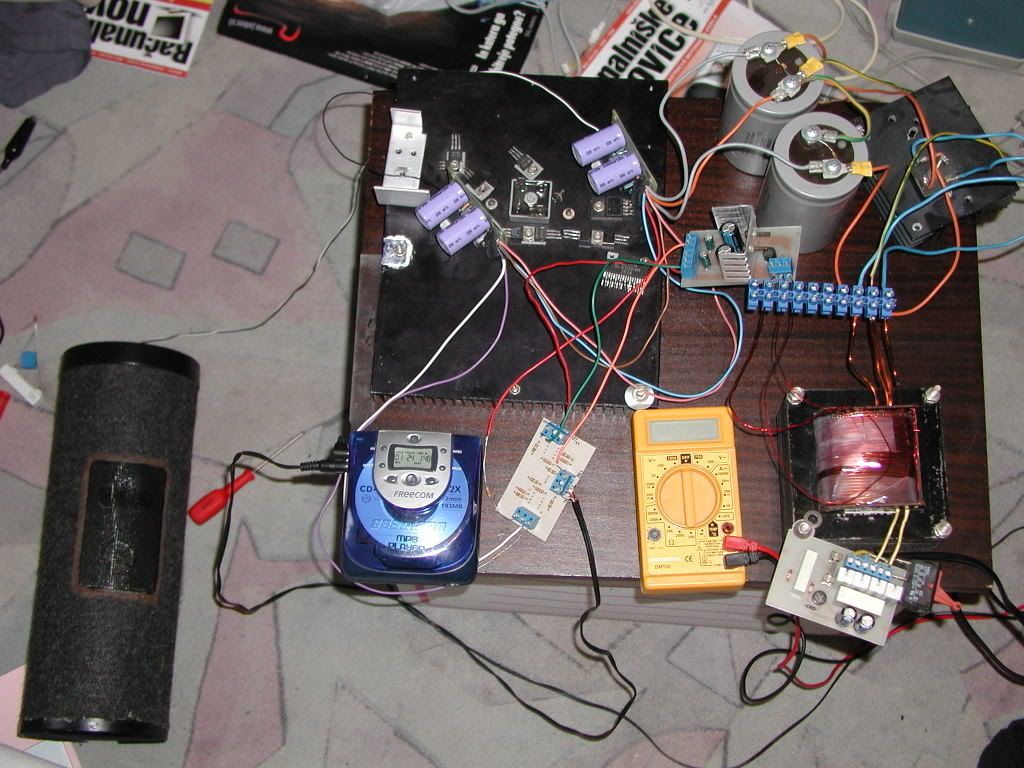So you believe that National is incorrect and you cannot get 200w out of 8 ohms @ +-37v? There is no way it will take +-57 volts to push 350w @ 4 ohms based on the method National used to find power out.
I think it will only take +-37.5v to push 350w and my chips will disipate 23w each. Read the application notes as I suggeted. Either way I will put together a board this week and give it a go.
I haven't blown an amp yet...
I think it will only take +-37.5v to push 350w and my chips will disipate 23w each. Read the application notes as I suggeted. Either way I will put together a board this week and give it a go.
I haven't blown an amp yet...
I'll give you a bit of credit. I read 57V not Vdc. So we are getting similar numbers. National did not seem to have an issue running at +-37vac or 52.4Vdc, so I don't see the issue with the voltage. They were very clear about not exceeding the dissipation power, which I am not. So I think it is safe.
Puffin, if you look for a high power output stage you should go for a discrete output stage:
http://cxem.net/doc/amp/LME49810.pdf
I would choose negative tempco mosfets (2SK1058/2SJ162) and remind you to use heavy source degeneration as mosfets really don't like to share the load. This should serve your purpose.
This driver is a really cool chip (I run it at 5-10 Wrms in a 100W amplifier and it sounds precious), but i can't understand why you need such a high power.
Elliot sound pages project 101 may also fit your needs You can look at the high power version to borrow ideas for the output stage. There are great discrete amps out there (Like the AKSA ones) but LME49810 is the most similar you can get to run at such powers.
Edit: It seems that vBulletin does not like unicode
http://cxem.net/doc/amp/LME49810.pdf
I would choose negative tempco mosfets (2SK1058/2SJ162) and remind you to use heavy source degeneration as mosfets really don't like to share the load. This should serve your purpose.
With a properly designed output stage and supply voltage of
+/-100V, an output power up to 500W can be generated at
0.05% THD+N into an 8 Ohms speaker load.
This driver is a really cool chip (I run it at 5-10 Wrms in a 100W amplifier and it sounds precious), but i can't understand why you need such a high power.
Elliot sound pages project 101 may also fit your needs You can look at the high power version to borrow ideas for the output stage. There are great discrete amps out there (Like the AKSA ones) but LME49810 is the most similar you can get to run at such powers.
Edit: It seems that vBulletin does not like unicode
AndrewT said:
no, bridged into 4ohms=more smoke.
Each channel in a bridged amp sees only half the load impedance at the output terminals.
Bridging into a 4ohm load is equivalent to driving a 2ohm with a single channel.
The standard rule for bridging is:- twice the power into twice the impedance.
Well I would agree, but you can drive 4ohm load in bridge mode too, I have done it... but supply was only +/-30v and for short time, just to see if bridging adapter worked. By driving 4ohm load you will hit current limit pretty fast, 8 or more ohme load should be connected only

Hi,luka said:Well I would agree, but you can drive 4ohm load in bridge mode too, I have done it... but supply was only +/-30v and for short time, just to see if bridging adapter worked. By driving 4ohm load you will hit current limit pretty fast, 8 or more ohm load should be connected only
That is a standard test I carry out.
Fit a resistive load of half the intended speaker impedance and check that the amp can drive it adequately (>=180% of max output power) and does so without any transient instability on the test waveform.
I would expect every competent amplifier that is designed to drive an 8ohm speaker to easily drive 4r0 for a few seconds. The output stage gets too hot too quickly and risks damage to the junctions if this maximum power "test" is continued too long. This implies that a good 4ohm amplifier should easily cope with driving 2r0 for a few seconds, but any responsible designer will never claim, unconditionally, that it is a 2ohm capable amplifier.
Just to clarify this stance, a 60degree phase angle 8ohm load stresses the output stage far more than a resistive 4r0 load.
- Status
- Not open for further replies.